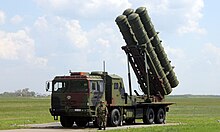HQ-22
| HQ-22 / FK-3 | |
|---|---|
 Serbian Armed Forces FK-3 (export version of HQ-22) | |
| Type | Surface-to-air missile |
| Place of origin | China |
| Service history | |
| In service | 2019–present |
| Used by | See § Operators |
| Production history | |
| Manufacturer | China Aerospace Science and Industry Corporation[1] |
| Specifications | |
| Engine | Rocket motor |
| Propellant | Solid fuel[1] |
Operational range | HQ-22: 170 kilometres (110 mi) FK-3: 100 kilometres (62 mi) |
Guidance system | Semi-active radar homing/radio-command guidance |
Launch platform | Ground |
The HQ-22 (simplified Chinese: 红旗-22; traditional Chinese: 紅旗-22; pinyin: Hóng Qí-22; lit. 'Red Banner-22') is a medium- to long-range semi-active radar homing/radio-command guidance air defence system developed and manufactured in China.[1]
History
[edit]The HQ-22 was publicly revealed at the 2016 China International Aviation & Aerospace Exhibition.[1]
The HQ-22 entered service with the People's Liberation Army Air Force (PLAAF) by 2019.[2]
Serbia purchased the FK-3, the export variant, in 2019; they were delivered by PLAAF Xi'an Y-20 transport aircraft and entered service in April 2022.[3] They were the first Chinese medium- or long-range air defence system exported to Europe.[4]
In April 2021, India reported that China had deployed the HQ-22 near eastern Ladakh.[5]
Description
[edit]The HQ-22 air defence system is a second generation development of the HQ-12 missile.[6] It is intended as a low-cost replacement for the HQ-2.[1]
The missile is "wingless" compared to the preceding HQ-12.[6] The missile uses semi-active radar guidance to reduce cost, and may switch to radio command guidance in an environment with "strong electronic interference".[1]
A HQ-22 unit includes four to eight transporter erector launchers, each with four missiles.[1] The radar vehicle reportedly permits six targets to be engaged simultaneously.[7]
The missile system has been widely compared to the United States' Patriot and Russia's mobile long range S-300 surface-to-air missile system. Although it has a shorter range than S-300 variants such as the S-300PMU-2, it is thought to benefit from superior electronic countermeasures (ECM) and superior capabilities against stealth targets at shorter ranges.
Variants
[edit]- HQ-22: Chinese domestic variant with speed of Mach 6 and a range of 170 kilometres (110 mi).[1]
- FK-3: Export variant with speed of Mach 6 and a maximum range of 100 kilometres (62 mi).[1]
Operators
[edit]- People's Liberation Army Air Force - 130+ HQ-22[8]
- Serbian Air Force and Air Defence - 4 batteries FK-3[9]
- Air and Coastal Defense Command - 3 batteries FK-3[10]
See also
[edit]References
[edit]Citations
[edit]- ^ a b c d e f g h i Kajal, Kapil (3 February 2023). "Royal Thai Navy unveils FK-3 air-defence system". Jane's Defence Weekly. Archived from the original on 26 April 2024. Retrieved 26 April 2024.
- ^ The International Institute for Strategic Studies (15 February 2019). The Military Balance 2019. London: Routledge. p. 262. ISBN 978-1857439885.
- ^ Bozinovski, Igor (6 May 2022). "Serbia unveils Chinese-made FK-3 air defence system". Jane's Defence Weekly. Archived from the original on 26 April 2024. Retrieved 26 April 2024.
- ^ Kastner, Jens (12 October 2023). "Serbia relies on China for weapons as tensions with Kosovo rise". Nikkei. Archived from the original on 13 October 2023. Retrieved 13 October 2023.
- ^ "India closely watching Chinese air defence batteries deployed near LAC". The Economic Times. Asian News International. 12 April 2021. Archived from the original on 21 April 2022. Retrieved 21 April 2022.
- ^ a b "Serbia Orders Chinese Air Defense System". DefenseWorld.net. 4 August 2020. Archived from the original on 6 August 2020. Retrieved 21 April 2022.
- ^ Chaudhary, Smriti (4 August 2020). "Did Russian S-400s Got Dumped for Chinese Air Defence System by an Aspiring EU Nation?". The EurAsian Times. Archived from the original on 9 April 2022. Retrieved 21 April 2022.
- ^ The International Institute for Strategic Studies 2024, p. 260.
- ^ The International Institute for Strategic Studies 2024, p. 134.
- ^ The International Institute for Strategic Studies 2024, p. 321.
Sources
[edit]- The International Institute for Strategic Studies (13 February 2024). The Military Balance 2024. London: Routledge. ISBN 978-1-032-78004-7.
